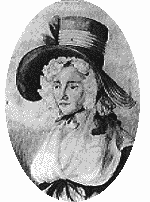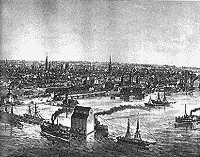 |
|
Mrs. Simcoe |
Toronto begins with the raw magic of geography - a place of breath-taking beauty for the First People who camp and settle temporarily here. Salmon fill the waters and game is plentiful. Flocks of pigeons number in the millions and take three days to pass over the area. When villages get too big, Natives relocate to avoid destroying the natural equilibrium of the area.
Europeans eye Toronto as a place of plunder, then as a strategic military location. The French build an outpost to defend against their British enemies; the British erect forts against their French and American foes. In 1787 the British buy Toronto from 3 Mississauga Chiefs for a measly £ 1,700 in goods and cash. The deal is a mess and is replaced by the 2nd Toronto Purchase of 1806.
Through over three hundred years, the changing relationship to the land defines Toronto and marks it in time. In 1793, Mrs. Simcoe, the wife of the first Lieutenant Governor, writes of the trees and clean water in her diaries. She marvels at the ability of the Mississauga to spear fish.
"At eight this dark evening we went to see salmon speared - large torches of white bark being carried in the boat. The blaze of light attracts the fish, which the Indians are dextrous at spearing. The manner of destroying the fish is disagreeable, but seeing them swimming in shoals around the boat is a very pretty sight. - Mrs. Simcoe, November 1, 1793.
 |
|
Toronto Bay, 1835, by George Howard |
Yet there is a terror of the land's vastness and power - a fear of being devoured. Early Europeans want to tame the wilderness and make it knowable; later industrialists will want to possess it and bury it under landfill and train tracks. The very shape of Toronto and its lake shore will be changed by two centuries of settlement.
 |
|
Map of Toronto, 1842 |
Thirty years after Mrs. Simcoe's diary entries, journalist Francis Collins writes about the horrible garbage floating in Lake Ontario. "It is really astonishing how the Magistrates can allow the horrible nuisance which now appears on the face of the bay. All the filth of the Town - dead horses, dogs, cats, manure...drop down...into the water which is used by almost all the Inhabitants on the bay shore." - Francis Collins, Canadian Freeman, 1824.
Thirty measly years after arriving, settlers turn Lake Ontario into a toilet bowl. In 1832 and 34, filth and overcrowding brings cholera epidemics that kill a tenth of the population. "Business was well nigh suspended, the prevailing panic keeping all visitors away. Stillness and death reigned in its deserted streets, traversed continually cholera carts conveying the dead to the grave and the dying to the hospital." - Reverend Dale, 1832. The horror of cholera forces city council to implement the first sewer system in 1834.
Poor public health plagues Toronto for another eighty years. "In 1912 we found 8,000 unsanitary houses...4500 houses overcrowded as tenements... surrounded by dirty foul-smelling undrained stables; manure heaps... evil-smelling privies... - Dr. Charles Hastings.
 |
|
City of Toronto from the Northern Grain Elevator, 1876. By G. Gascard |
Health inspector Dr. Charles Hastings loses his own daughter to typhoid because of polluted milk. In 1912, he goes on a personal crusade of disease prevention. Hastings demolishes over 15,000 out-houses, establishes public health nursing and pasteurizes milk - the first in the country. Within ten years Toronto has the lowest mortality rate of any city in North America.
While the land is disinfected of some of its man-made toxins, it becomes unrecognizable under the weight of modern concrete. The shore line is drastically altered; landfill pushes back the lake from where it once lapped up against Union Station and St. Lawrence market. The Gardiner Expressway is hoisted up on stilts, blocking the lake view from citizens. Rivers are polluted by industry and sewage, and the Don, diverted. The stunning ravines and creeks that soften the place are built over or plugged.
Next: War and The Politics of Identity
| 